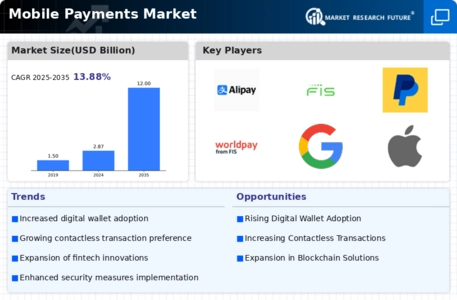Market Trends
Key Emerging Trends in the Mobile Payments Market
The mobile payments market has undergone significant transformations in recent years, reflecting the dynamic nature of the digital landscape. One prominent trend is the escalating adoption of mobile payment solutions across diverse industries. As consumers increasingly prioritize convenience and efficiency, mobile payments have emerged as a preferred method for transactions. The widespread availability of smartphones and the proliferation of secure payment apps contribute to the growing acceptance of mobile payments.
Another notable trend is the integration of innovative technologies, such as Near Field Communication (NFC) and biometric authentication, into mobile payment systems. NFC facilitates seamless transactions by allowing users to make payments with a simple tap, while biometric authentication enhances security through features like fingerprint or facial recognition. These advancements not only streamline the payment process but also bolster trust among users by ensuring robust security measures.
The global shift towards a cashless society has played a pivotal role in shaping mobile payment trends. With the rise of e-commerce and the advent of contactless payment options, consumers are gradually moving away from traditional cash transactions. This transition is driven by the convenience of mobile payments, as users can effortlessly make purchases, transfer funds, and manage their finances with just a few taps on their smartphones. As businesses adapt to this evolving landscape, mobile payment solutions become increasingly integral to their operations.
Furthermore, the mobile payments market is witnessing a surge in partnerships and collaborations between financial institutions, technology companies, and mobile service providers. These strategic alliances aim to create comprehensive ecosystems that offer users a seamless and interconnected experience across various platforms. By combining expertise and resources, these collaborations contribute to the development of more robust and user-friendly mobile payment solutions.
The emergence of cryptocurrencies and blockchain technology has also left an indelible mark on the mobile payments market. Some mobile payment platforms now support cryptocurrency transactions, providing users with additional options for conducting financial transactions. The decentralized and secure nature of blockchain enhances the transparency and trustworthiness of these transactions, further contributing to the diversification of mobile payment methods.
In addition to these trends, the global COVID-19 pandemic has accelerated the adoption of mobile payments as people seek contactless alternatives to minimize physical interactions. The increased awareness of hygiene and safety concerns has prompted both businesses and consumers to prioritize mobile payment solutions, further solidifying their position in the market.

















Leave a Comment